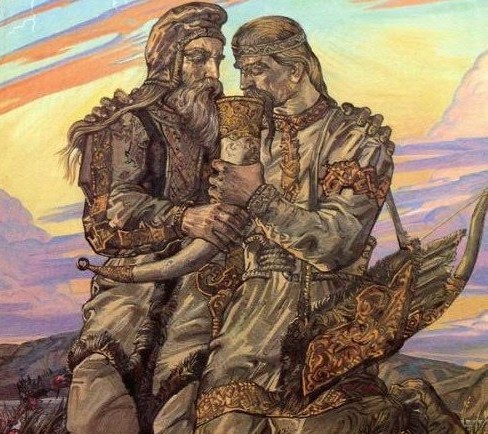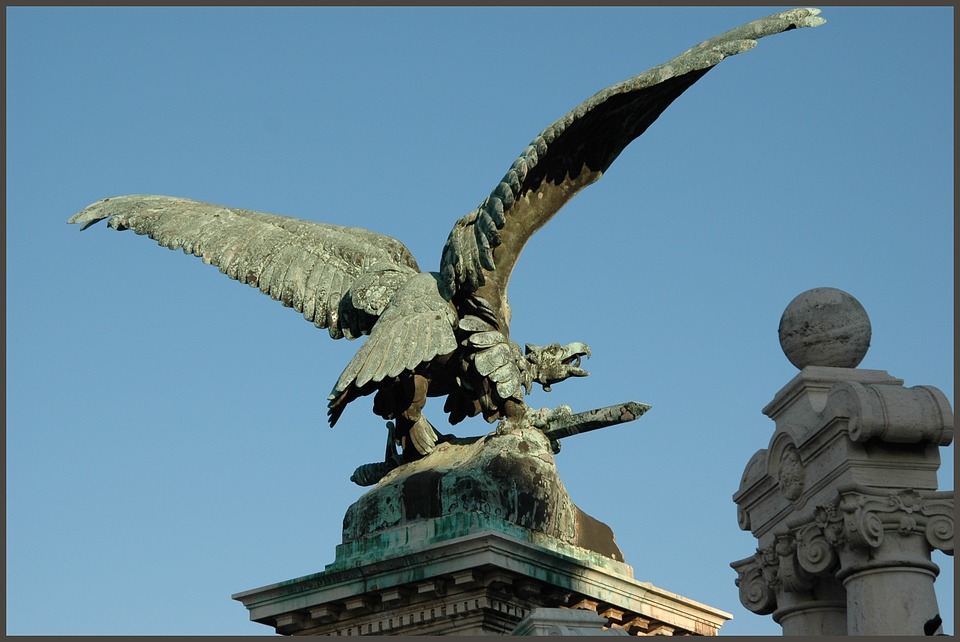_A BASIC INTRODUCTION_
The old magyar religion was a polytheist religion, formed by a mix of both gods with human form and sacred creatures. The comparison between the tengriism practiced by the turko-mongolic and the alan people with the hungarian one is like compare the greek hellenism with the roman one, both are tecnically the same religion, but the roman one is a transformation of the old beliefs, that were changed for political or ideological reasons. The magyars probably embraced the tengriist belief around th IV-V century aC after probably being conquered by the Khazars, a turkic tribe that was expelled by other tribes and moved towards the west in search of a land to settle; Alongisde the adapting religion, the magyars also "turkified" their culture by adopting traditions and also adapting into a nomadic life-style.
Despite most dieties in the magyar beliefs are exactly like their tengriist counter-parts, some dieties and religious traditions seem to resemble or being closer of other religions, specially finno-uralic, germanic, iranic and some even point out semithic.
Like many pagan religions as tengriism and the norse belief, the magyars belived that the world is a tree ("Világfa" in Hungarian) composed by different layers, the top layer is where the main and elder dieties, the middle layer where fantastic creatures lived and secondary dieties, lesser gods, fantastic creatures and the humans, the last layer was a hell-like domain, where the bad souls went.
,_Gödöllő,_Budapest,_Hungary.png)
(^A statue of the world tree in Budapest, Hungary )
_DIETIES_
Dear Golden Father: The "Golden Father" or "Arany Atyácska", sometimes mentioned as "Isten" ("God" in Hungarian), is the god representative of the skies and is the god of creation. As the name suggests, he's the father of all the secondary gods; His nature is often valued as benevolent. The origin of the diety is still on debate between if is just an hungarian adaptation of Ten-gri, the main god of tengriism or Anu, the main god of the sumerian religion. His alternate name, "Isten", is used now at days to refer at the abrahamic god.
Dear Dawn Mother: The "Dawn Mother" or "Hajnal Anyácska", or sometimes mentioned as "Boldogasszony" is the main female diety, being goddess of the moon, fertility, land and the childbirth. As the name suggests, she's the mother of the secondary gods and the wife of the "Golden Father". Her alternate name, "Boldogasszony", is now at days used to refer to Virgin Mary.

(^ Screenshot of the animated movie "Fehérlófia" or "The son of the white mare" showing both the golden father on the left and the dawn mother on the right. The movie is indeed, the worst LSD trip I've passed throught, worst than Heavy Metal and The Beatles: The Yellow Submarine movie )
King of the Sun: The sun, or also called "Napkirály" is one of the main secondary dieties, being the oldest of the three sons of the Golden Father and the Dawn Mother. According to legend, he rides on the sky with a silver haired horse from East to West. As a child, he was involved in the creation of the world. His name in hungarian, "Napkirály", is also used to refer to Louis XIV of France, the "Sun King".
King of the Wind: "Szélkirály", also known as the "King of the Wind" is the second son of the two parental dieties, this diety is the god of the winds, storms and the rain. According to legend, he wears a silver armor. This god is the hungarian counter-part of "Yel Ata". the god of the winds in the tengriist paganism.
Warlock: "Hadak Ura", "Hodúr" or "Hadúr" (being the last one the most common and popular name) was the youngest of the three brothers, was the god of war and blacksmith of the dieties. According to legend, he used to wear a copper armor and weaponry, and he is often represented as a horse-archer. Some claim that the "Sword of Mars", the sword that held Attila the Hun, was made by him.

(^Modern illustration of Napkirály on the left and Hadúr on the right)
_FANTASTIC CREATURES, MONSTERS, FAIRIES AND WITCHES_
The hungarian mythology has many different of sacred beings that each one has different levels of relevance or meaning.
The White Stag: The "White Stag", the "Miracolous Stag" or "Csodaszarvas" is an emblemathic creature of the hungarian mythology. The legend of Hunor and Magor is based about the hunt of this creature and the origin of the hungarians as a whole. The origin of this creature is probably Uralic as creatures as the stag or the elks have heavy weight inside the finno-uralic religious symbology.

( ^ Metallic figure that represents the Miracolous Stag )
Turul Hawk: The Turul is the most important of the hungarian mythological creatures as is used as the main symbol representing the hungarian people. The Turul probably reached popularity thanks to the turkic influence where eagles were often used as symbols of different tribes (the Pechenegs were one of them).

(^ A statue of a Turul in the Buda castle, Budapest, Hungary)
Bába: Meaning "old woman" in hungarian, is a magical and maleficent creature that lives in fountains who drowned children.
Witches: Called "Boszorkány" in Hungarian, were evil old women who used magic for evil pouposes. They had the hability of transforming, flying and create curses. The witches often corrupted animals, specially cattle, so it could produce illness.
Fene: The Fene would be an equivalent of a western devil, but is common linked with sickness. Also, "Fene" is the name of where all the evil beings live.
Garabonciás : The "Garabonciás" were male humans with magical capabilities. According to legend, they were able to control the weather.
Guta : The Guta was an evil spirit who clubbed his victims to death, he's often related to heart attacks and paralysis.
Szépasszony : Meaning "young lady". Is described as a young woman who wear white dresses, who appear dancing during storms and secudes young men.
Vadleany : This spirit is similar to the last one but malevolent. This one is an evil spirit who appears as a naked teen girl with extremly long hair who seduces travelers, wanderers or shepherds and drain their life away. This creature is most likely to be of Norse-Slavic origin.
Griff : Is the hungarian adaptation of the western Griffin but with some changes. The magyar Griff is extremly similar to the Turul in appareance, but his nature is evil, as in different tales are described as greedy and man-eating monsters.
_EARLY NATIONALISM INSIDE THE MAGYAR MYTHOLOGY_
Inside the magyar mythology, military legends has been linked with sacred entities for justify the origin of the hungarian people or the holy origin of the Árpád dynasty.
The Turul became the symbol of the hungarians as according to the legends, it was assigned by the Golden Father to become the guide of the magyar people, plus, is several involvements in the legends about the old magyar princes, specially with Álmós, the founder of the Árpád dynasty.
In a legend, the Miracolous Stag was a prey of Hunor and Magor. This legend and those two characters are probably created during the medieval times (likely the early XIII century) as Hunor and Magor as allegories to refer to the Hunnic and Magyar people and that they've a linked origin. But once again, the legend is most likely to be of medieval origin and making the link for justify a fantastic past or that the magyar people was blessed, like other cultures do, like castillians did with El Cid and the catalans & aragonese with Saint George by participating in wars alonside them.
_TRADITIONS AND PRACTICE_
The magyars were very unique in the terms of practice, the main representatives of the religion were the Táltos, who would be the equivalent of the shamans in other pagan religions. The táltos were unique in the sense that they were chosen since birth by the gods; this "selection" was shown by the ownership of unique physical traits: natural white hair, having teeth since birth, having 11 or 12 fingers, and other things. According to the magyars, the tátlos were born with all their knowledge, they were born ready. This "shamans" had different pourposes, from healing illness and fortune-telling to notify about invading forces or stop cultural collapse. This monks used to perform rithuals as meditation and dances. Compared to other religions, the táltos used to own horses, that in appareance were weak and unnapealing but inside they were magic. This tradition of monks lived even when catholicism was the main religion in Hungary, but there's several guests that this tradition came to an end in the beginnings of the Habsburg era in Hungary (mid-late XVI century).
Another well known ancient tradition of the magyars was to sacrifice white horses, stags or cattle in honor of the warlord god Hadúr. This traidition is of obvious iranic origin as other nomadic iranic peoples as the Alans, Scythians and Sarmathians practiced it similarly.
Now at days there's several neo-pagan organizations that try to revive this old cult, and is one of the predominant neo-pagan religions in Hungary alongside hellenism and the egyptian religion.
I hope you loved it, and expect some more content soon, but it might take a while.

Another great article Mr.! Well done, please join the team :)
This comment is currently awaiting admin approval, join now to view.
This comment is currently awaiting admin approval, join now to view.
Nice article, I was trying to hunt down that weird acid trip of a movie and ended up back here of all places regarding it.